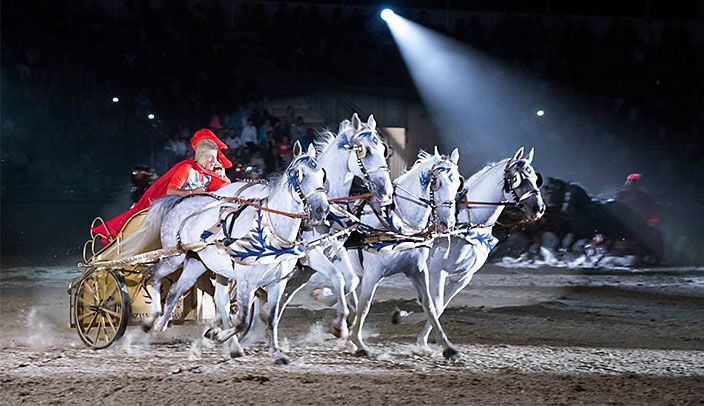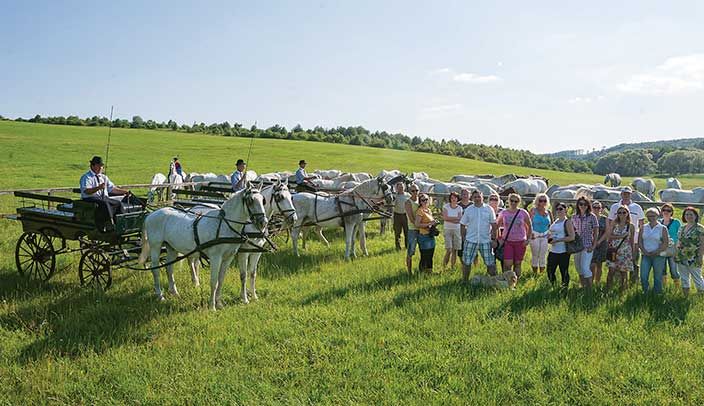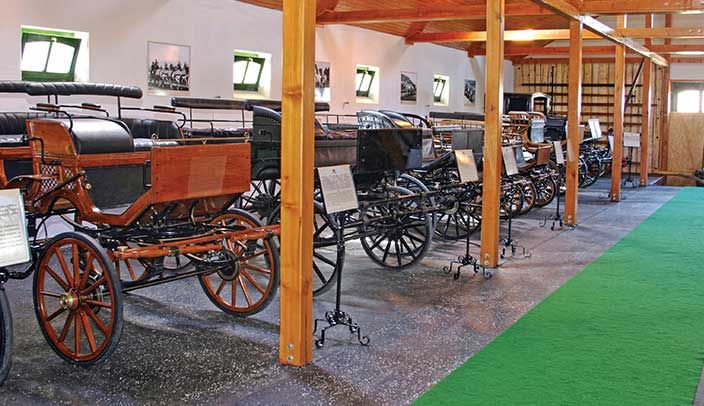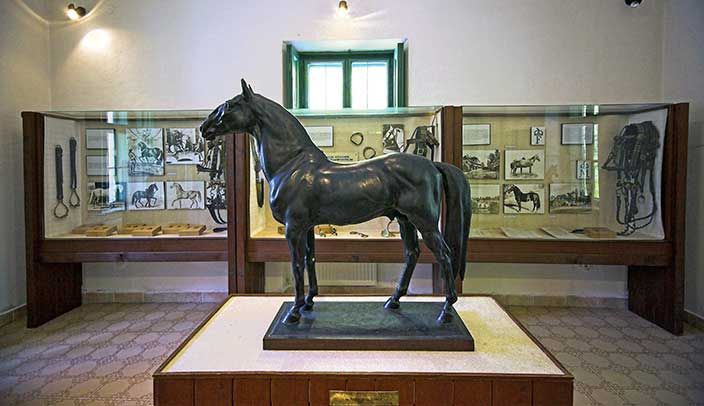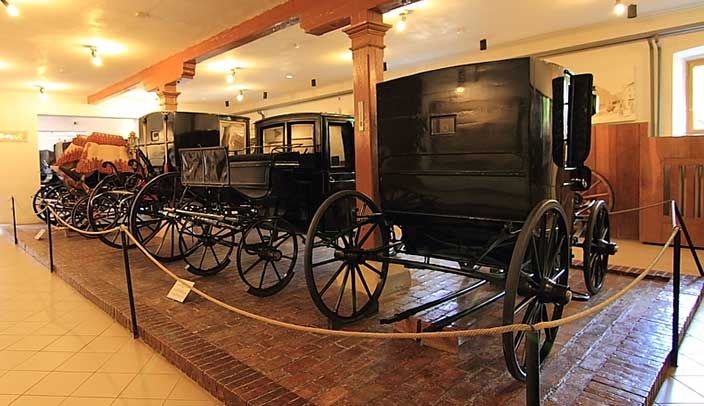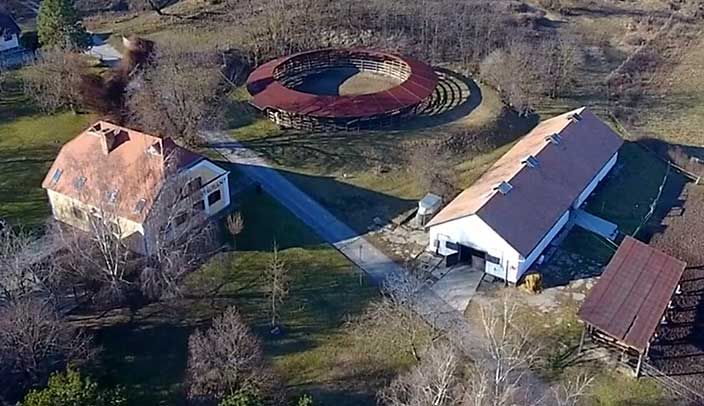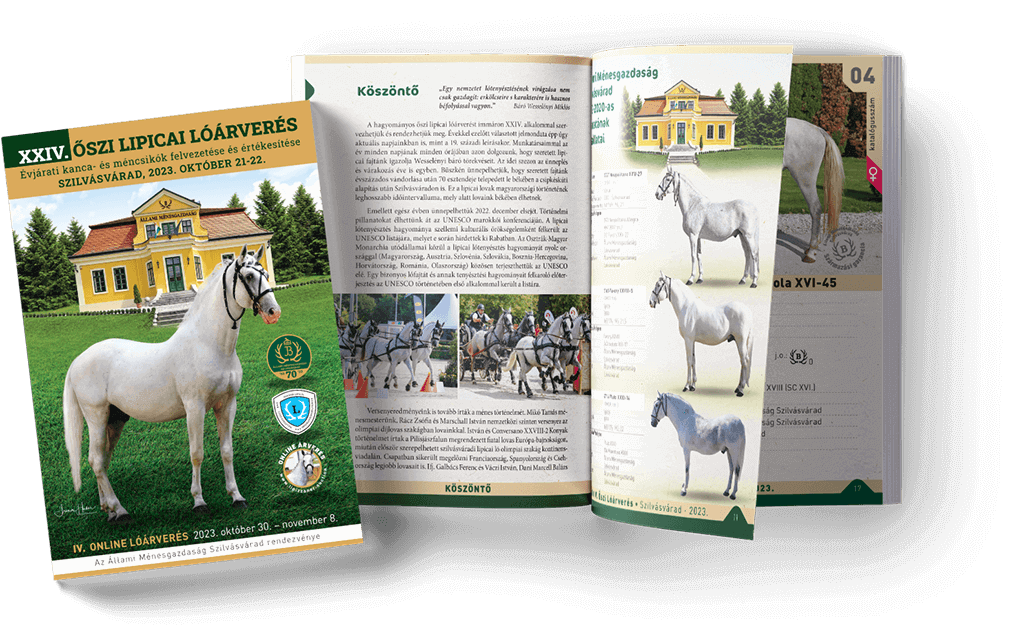The history of the Lipizzaner breed
 The formation of the breed
The formation of the breed
Lime- means linden tree, in Slovenian lipa, lipovec or lipizza (pronounced lipica). The linden tree is considered by the Slavs to be the tree of life. In Europe, its most common type is the silver linden (Tilia argentea) with its beautiful, rich canopy, which can reach up to 1,200 years of age and a trunk width of several meters. The linden tree was already worshiped as an idol in pagan legends. Under its canopy, Slovenes gathered for religious ceremonies, where they danced and told stories.
 The tree in the middle of the village was considered the core of the settlement. One document from the second half XV. century proves that a winery stood in front of a small village near Lokev, with a small linden tree (so-called lipica) next to it. In this place, the villagers gathered for a glass of wine. According to the locals, the small village was named after this tree and the horses bred there also bear this name.
The tree in the middle of the village was considered the core of the settlement. One document from the second half XV. century proves that a winery stood in front of a small village near Lokev, with a small linden tree (so-called lipica) next to it. In this place, the villagers gathered for a glass of wine. According to the locals, the small village was named after this tree and the horses bred there also bear this name.
In May 1580, a decision was made to set up a royal stud in Lipica (then Lipizza) on the Opcinai Plateau, which was then part of the Habsburg Empire. The stud was founded by the son of Austrian Emperor Ferdinand I II. It is associated with the name of Archduke Károly.
The goal stated at the time was as follows: "... the best horses should be bred here, which will be presented for the imperial court. They should be the best and most tolerant horses. They should walk on hard and stony ground, where little grass grows."
The barren Karst Mountains are therefore the cradle of the breed, where even the Romans kept and raised horses. Their late descendants were known by the locals as "karst horses", which also played a role in the breeding of the Lipizzaner.
However, the decisive blood ratio in the creation of the breed was given by the Spanish horse, which was extremely fashionable at the time.
Strictly selected mares and stallions were constantly arriving from Andalucia. At that time, the House of Habsburg also ruled the Spanish throne, so it could not have been a problem for excellent individuals to establish a new breed in Lipica. In the karst region with extremely sparse vegetation, the horses were fed with high-quality, nutrient-rich hay and oats delivered from Hungary.
During the reign of Leopold I (1658-1705) and József I (1707-1711), inspired by the Baroque style, Lipica developed into the central stud of the Habsburg monarchy. The Spanish Riding School, founded in 1572, was founded by IV. Károly moved it to a new location in 1735, the Hofburg, perhaps the most beautiful baroque building in Vienna. The riding school's horses were provided by Lipica. Only the best stallions were brought back to Lipica to become the sires of the next generations.
After the decline of horse breeding in Spain, horses were brought to Lipica from Polesina in upper Italy and other prominent studs of the time, from Naples, Denmark, Germany, as well as from the royal stud farm of Kladruby. Looking back to the second half of the 18th century, we find five of the six classic Lipizzan bloodlines that still exist today: Pluto, Conversano, Neapolitano, Maestoso, Favory.
The founding stallions of these bloodlines were:
Original Danish stallion: Pluto, grey, born in 1765 at the Royal Stud of Frederiksburg.
Neapolitan stallion: Conversano Senior, black, born in 1767, and Neapolitano Senior,bay gelding, born in 1770.
Kladruby stallions: Maestoso Senior, grey born in 1773 and Favory Senior, grey, born in 1779.
The Arabian bloodline: Siglavy (its origins can be traced back to the 19th century) whose founder is Siglavy Senior, grey, born in 1810.
The breed has two other Hungarian-related bloodlines: Incitato, born in 1810 at Count Pál Bethlen's stud in Boncida, after an original Spanish mare and stallion. The formation of the Tulipan tribe (at the end of the 1800s) is linked to the name of the Jankovichs. For the original Spanish and Lipizzan mares they bought, they used a stallion from the Favory line called Tulipan, whose descendants gave rise to the later Tulipan line.
Datas regarding classic mare families also come from this period:
Karst mares: Sardinia (mares from this family are called Betalka), Spadiglia (Monteaura in Lipica), Argentina (Slava Lipicán).
Kladruby mares: Afrika, Almerina (Slavina, Samira Lipican), Presciana/Bradamante (Bonadea in Lipica), Englanderia (Allegra in Lipica), Europa (Trompeta in Lipica), Capriola (not represented in Lipica), Rava (not represented in Lipica).
Kopcani mare: Stornella/Fistula (Steaka Lipican), Ivanka/Famosa (Famosa in Lipica).
Danish mares: Deflorata (Capriola, Canissa in Lipica)
Arabian mares: Gidrana (Gaeta, Gaetana Lipican), Djebrin Arabian half-bred mare (Dubovina Lipican), ), Mercurio Arabian half-bred mare (Gratiosa Lipican), Theodorosta Arabian half-bred mare (Wera Lipican).
The Napoleonic wars meant a difficult period for the Lipizzaner breed. Since the beginning of the war, the Lipica stud has fled the Karst three times, most often to Hungary. After the third escape, six years passed before they returned home. After that, Napoleon gave the Lipica stud to Marshal Marmont, who in turn leased it to unscrupulous breeders.
Arabian horses were used in breeding in Lipizzaner for the purpose of blood renewal. Many Arabian stallions gave the stud magnificent offspring, and the Siglavy tribe and the Arabian mare families can be traced back to this time.
In the 19th century, Lipizzan horses spread throughout the empire, not only in the military studs of Radautz, Mezőhegyes and Piber, but countless smaller breeding studs were established among the farmers of the Danube Region.
 In 1915, shortly after the outbreak of World War I, the Lipizzan stud was evacuated to Laxenburg near Vienna, and the foals were taken to Kladruby. After the war, the Karst Mountains and Lipica were annexed to Italy. The Czechoslovak Republic confiscated all the Lipizzan horses kept in Kaldruby and in 1921 moved them to the new Topolcanky stud, in today's Slovakia. The Italian state claimed all 179 horses kept in Laxenburg. After a long discussion, the culture was divided into two parts. Italy received 107 horses, which were sent back to Lipica on July 16, 1919. On November 5, the Austrians transported the remaining 97 horses from the Lipizzan stud to Piber, Austria. From then on, the Lipizzan stallions at the Vienna riding school were provided by the Piber stud. The imperial Lipica Royal Stud has ceased to exist.
In 1915, shortly after the outbreak of World War I, the Lipizzan stud was evacuated to Laxenburg near Vienna, and the foals were taken to Kladruby. After the war, the Karst Mountains and Lipica were annexed to Italy. The Czechoslovak Republic confiscated all the Lipizzan horses kept in Kaldruby and in 1921 moved them to the new Topolcanky stud, in today's Slovakia. The Italian state claimed all 179 horses kept in Laxenburg. After a long discussion, the culture was divided into two parts. Italy received 107 horses, which were sent back to Lipica on July 16, 1919. On November 5, the Austrians transported the remaining 97 horses from the Lipizzan stud to Piber, Austria. From then on, the Lipizzan stallions at the Vienna riding school were provided by the Piber stud. The imperial Lipica Royal Stud has ceased to exist.
 The Lipica farm was taken over by the Italian Ministry of Defense. One day after the surrender of Italy on September 8, 1943, the Lipizzan stud fell into German hands. On October 16 of that year, all 179 horses were evacuated to Hostau. From the studs in the areas under German control, the horses from the Stancici and Krusedoli studs of Yugoslavia, the royal breeding of Demir Kapija (Macedonia), the Austrian Piber, the Hungarian Bábolna and the Slovak Tapolcianky were kept and transported to Hostoun, and at the end of the war, the Germans evacuated the Lipizzan horses from Houston to Schwarzenberg. Some of these horses were taken to Mansbach, the rest to Ried in Austria. The American army gave the Lipizzan stud, together with its archives, to Italy, while the other part went to the Austrians, who revived the Piber stud. In 1947, the greater part of the Karst Mountains, and with it Lipica, was annexed to Yugoslavia. Finally, in December 1947, some of the horses returned to Lipica. At the end of 1947, Lipica had 23 stud stallions, with which Lipica breeding could start again.
The Lipica farm was taken over by the Italian Ministry of Defense. One day after the surrender of Italy on September 8, 1943, the Lipizzan stud fell into German hands. On October 16 of that year, all 179 horses were evacuated to Hostau. From the studs in the areas under German control, the horses from the Stancici and Krusedoli studs of Yugoslavia, the royal breeding of Demir Kapija (Macedonia), the Austrian Piber, the Hungarian Bábolna and the Slovak Tapolcianky were kept and transported to Hostoun, and at the end of the war, the Germans evacuated the Lipizzan horses from Houston to Schwarzenberg. Some of these horses were taken to Mansbach, the rest to Ried in Austria. The American army gave the Lipizzan stud, together with its archives, to Italy, while the other part went to the Austrians, who revived the Piber stud. In 1947, the greater part of the Karst Mountains, and with it Lipica, was annexed to Yugoslavia. Finally, in December 1947, some of the horses returned to Lipica. At the end of 1947, Lipica had 23 stud stallions, with which Lipica breeding could start again.
In 1948 and 1949, many Lipica horses from the old Demir Kapija and Vukovar farms were returned to Lipica. In 1952, Lipica again bought 11 horses from Kutjevo, while later, for breeding purposes, it bought many horses from the other Yugoslav republics - Dakovo, Karadjordjevo, Vucijak - as well as Piber in Austria and Fara Sabina in Italy.
By 1980, all the classic bloodlines of stallions and mares were once again represented in the Lipica stud. In 1991, Slovenia gained independence. Today, in Slovenia, the Lipica breeding is maintained by the National Lipica Stud (Kobilarna Lipica).
The arrival of Lipizzaner breed to Hungary
Horse breeding in Lipica dates back to the beginning of the 1800s, when the stud was relocated from Lipica to Mezőhegyes after fleeing Napoleon's armies.
After the dangers of the war passed - more than six years - not all the horses returned to Lipica, but a good part of the number that swelled in the meantime - which numbered around 3,000 other horses - remained at the military stud in Mezőhegyes.
As a result of the nearly seven decades of breeding and keeping in Mezőhegyes, the breed's character began to change in some respects as a result of the existing "clump effect". Mezőhegyes and its surroundings are a lowland region with extremely fertile soil and a climate that also promotes abundant harvest. As a result, the horses crowded together, climbed on top of each other, and at the same time lost their body strength characteristic of mountain horses.
In order to solve this problem, the decision was made to relocate the people of Lipica from Mezőhegyes to Transylvania, Fogaras. The resettlement took place in 1874/75. The horses were once again in a mountainous environment suitable for the needs of the breed. The almost 40 years spent at Fogaras were a very fruitful period for strengthening the breed.
In 1912, escaping from the First World War, the then Ministry of Agriculture made a decision to transfer the stud from Lipica to the Hungarian Royal Bábolnai Stud. Babolna was also an extremely valuable period for the breed from the point of view of breeding, despite the fact that it moved from the snows of the mountains back to the sands of the plains.
The Bábolna period also lasted 40 years. Based on a decision made in 1947 in order to preserve the character of the breed, in 1950 the construction of a foal breeding farm was started in Csipkéskút, located on the Bükk Plateau at an altitude of 870 m above sea level. After that, the continuous resettlement of the Lipica breed from Bábolna to the Bükk Mountains and Szilvásvárad began. In 1912, escaping from the First World War, the then Ministry of Agriculture made a decision to transfer the stud from Lipica to the Hungarian Royal Bábolnai Stud. Babolna was also an extremely valuable period for the breed from the point of view of breeding, despite the fact that it moved from the snows of the mountains back to the sands of the plains.
 Szilvásvárad and its surroundings (the Bükk Mountains) are the landscape unit in today's Hungary that is most similar in its natural features to Lipica, the original place of cultivation.
Szilvásvárad and its surroundings (the Bükk Mountains) are the landscape unit in today's Hungary that is most similar in its natural features to Lipica, the original place of cultivation.
In terms of soil conditions, vegetation, altitude and climate, we managed to find a place here that guarantees the long-term preservation of the character of this traditional breed, influenced by the environment.
January 22, 1953: The Szilvásvárad State Farm was established by the founding decision issued by the Ministry of State Farms and Forests. As his task, he ordered the maintenance of the stock breeding in Lipica in Hungary. Through several organizational transformations, the successor of the stock breeding farm is today's State Stud Farm Szilvásvárad.
Genealogical lines
In the maintenance of the Lipizzan horse as a traditional breed with a closed pedigree, it is of particular importance to respect tradition, as well as to carry on the preservation of the characteristic - primarily external - value-measuring qualities of established genealogical lines and mare families.
Pluto
Törzsjele: P, Anyajele: 
Pluto Senior, a gray stallion, arrived in Lipica in 1772 from Denmark, from the royal stud in Friedrichsburg, which at that time bred horses of Spanish blood, known all over Europe. In the stud, the Slovenian 4506 Pluto Steaka XVI (XXXIII tm) represented the line for the last time.
Conversano
Törzsjele: C , Anyajele: 
The Conversano line traces its origins back to Naples. It happened that Mária Theresa's eldest daughter, Mária Karolina VI. was married to King Ferdinand of Bourbon of Naples. The event is also attended by Prince Kaunitz, who moves to Naples and establishes a small stud from the high-quality horse stock in the area, which soon becomes the best stud in the kingdom. From this breed, the black Conversano Senior, which was already a stock stallion in the court stud in 1774, was brought to Lipica. The line is currently covered by 4574 Conversano Krabbe III-1 (XXVII tm) in Szilvásvárad.
Favory
Törzsjele: F, Anyajele: 
Favory Senior was born in 1779 in Kladruby, the breeder of the monarchy's heavy-harnessed, Spanish-Neapolitan-type court horses. In order to increase the mass, breeding individuals from this stud were later transferred to the Lipica breed several times. The pale-colored Favory Senior was bred in Lipica in 1783, creating one of the most successful stud lines of the breed. In Szilvásvárad, 4101 stallion Favory Allegra XXVI (XXVIII tm) is currently covering.
Maestoso
Törzsjele: M, Anyajele: 
At the same time as Favory, the original Spanish Maestoso Senior is transferred from Kladruby to Lipica. The excellent Spanish stallion, with its good appearance and movement, establishes a powerful tribe in the Lipizzan breed. Szilvásvárad has been breeding with 4969 Maestoso Bellamira - 37 (XXXIII tm), bred in Piber.
Neapolitano
Törzsjele: N, Anyajele: 
The beginning of Neapolitano Senior's breeding activity is also linked to the year 1783. As the name suggests, it is a line of Neapolitan origin. The 13-year-old, excellent-looking stallion made the long journey from Naples to Lipica under saddle. The stallion Neapolitano, who was then almost unanimously chosen as a breeding stallion for the grey herd, could only owe this honor to his exceptional qualities, which he thanked the Lipizzaner breed with a strain that has survived to this day.
Siglavy Capriola
Törzsjele: S, Anyajele: 
The Arabian stallion named Siglavy, the founder of the line came to Lipica in 1816. His height at the withers did not reach 150 cm. The stallion came from the breeding of Prince Schwarzenberg, both of his parents were original Arabian horses. The inheritance of the little stallion proved to be so successful that his tribe has survived to this day. The line was epresented in Szilvásvárad by the stallion Siglavy Capriola XIV and Siglavy Samira.
Incitato
Törzsjele: I, Anyajele: 
The Incitato line is of Transylvanian Hungarian origin. In 1802, Count Pál Bethlen bought some of the original Spanish horses that arrived at that time for his own breeding from the already famous stud in Bonchida. Among them was the stallion Curioso and the mare Capelano. Incitato Senior, the founding stallion of the tline, was born from the pairing of the two in the spring of 1810. The rambling stallion with good qualities was noticed by the military stud in Mezőhegyes and purchased in 1814. From 1815, Incitato covered the Lipizzan mares in Mezőhegyes. Later, Mezőhegyesen was covered by the sons of 22 stock stallions in the isolated Incitato stud. The Incitatos that have survived to this day come from a stallion bred in this stud, from mother and father Incitato. A son of this stallion from a Shagya VI mare received the stock stud number Incitato I, in the herd that was later moved from Mezőhegyes to Fogaras. The stud is has been covered by the stud's own bred 3762 Incitato XIII - 2 (XIV tm.) and 4325 Incitato XIII-22 (XV tm.) stock stallions in Szilvásvárad.
Tulipán
Törzsjele: T, Anyajele: 
The cultivation of the Tulip strain also praises the Hungarian horse breeding. At the end of the 19th century, the Jankovich-Bésán family was famous for its horse breeding. He operated a quality Lipizzaner breed in his Trezovác stud located in Bácska. To show its importance, it is enough to mention that the Hungarian State Lipica Stud, operating in Fogaras at that time, also bought several horses from Trezovác, so all the Plutos living today come from a stock stallion bred here, but the Maestoso and Neapolitano stocks also received life-saving blood transfusions from here. However, in the horse breeder's mind, Trezovác's name is mostly associated with the breeding of the Tulipán line, which was born using the original Spanish import and Lipizzan mares of the Jankovichs, as well as the stallion Tulipán of the Favory strain. Stallions born from these pairings with Tulipán paternity were later established as stock stallions in Fogaras and then Bábolnán as stock stallions in the state studs. The irony of fate is that this strain completely disappeared from Hungarian breeding during the storms of the First World War, and it was only after a long time, from 1970, that Tulip was successfully established again in Szilvásvárad - first from an import from Yugoslavia. He was followed shortly, in 1972, by the Romanian Tulipán I. Today's Tulipán tribe in Szilvásvárad is based on these two stallions. In the stud in 2010, 5132 Tulipan Toplica XIV (VIII tm) bred in Djakovo was covered.



